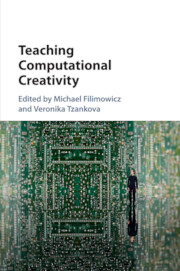Book contents
- Teaching Computational Creativity
- Teaching Computational Creativity
- Copyright page
- Contents
- Figures
- Tables
- Notes on Contributors
- Acknowledgments
- Introduction: Pedagogies at the Intersection of Disciplines
- PART I NEW FOUNDATIONS
- PART II CODE AS MEDIUM
- PART III PHYSICAL{LY} COMPUTING
- PART IV ONLINE LEARNING
- PART V CRITICAL PEDAGOGY
- PART VI TRANSDISCIPLINARY
- Interviews
- Afterword: Toward a Curricular Synthesis
- Index
- References
PART II - CODE AS MEDIUM
Published online by Cambridge University Press: 04 July 2017
- Teaching Computational Creativity
- Teaching Computational Creativity
- Copyright page
- Contents
- Figures
- Tables
- Notes on Contributors
- Acknowledgments
- Introduction: Pedagogies at the Intersection of Disciplines
- PART I NEW FOUNDATIONS
- PART II CODE AS MEDIUM
- PART III PHYSICAL{LY} COMPUTING
- PART IV ONLINE LEARNING
- PART V CRITICAL PEDAGOGY
- PART VI TRANSDISCIPLINARY
- Interviews
- Afterword: Toward a Curricular Synthesis
- Index
- References
Summary
Code is the pervasive, invisible material that drives our contemporary mediated environment: the electricity flowing through our landscapes, the models of environmental collapse, and billions of dollars spent distracting people from considering what that collapse might mean. Code is not merely on the backend of the actual mainstream art worlds of cinema and video games; it has become a driving aesthetic. While our students may detour through galleries and museums, they carry around intensely powerful, networked, code-driven devices and soon return to larger screens to further engage with software and social media. The foundation of contemporary art and design practices is code. Teaching and learning the code underlying all new media is challenging. Mere access to information does not prompt students to teach themselves. The introduction of code to first-year postsecondary students can occur through critical discourse and be connected to more than future job prospects. Who can read and write code right now? What kind of programs are they writing? What kinds of questions are being asked? Whose voices are present? Are critical perspectives about code happening in art and design worlds? Are radical, boundary-pushing queries being made? ARRAY foregrounds code literacy and agency for artists and designers in an effort to address these questions.
- Type
- Chapter
- Information
- Teaching Computational Creativity , pp. 73 - 104Publisher: Cambridge University PressPrint publication year: 2017



